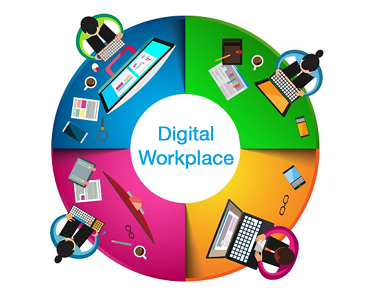5 Trends Shaping the Digital Workplace
— July 23, 2019
While 95 percent of the organizations agree that a digital workplace is important for their business, only 44 percent of them have already implemented digital workplace programs.

Digital workplaces have companies thinking from an entirely new angle. A digital workplace is the set of digital tools that an employee need to get work done. It includes communication, collaboration, and how repetitive work is managed and controlled. Digital workplaces enable remote working and allow teams to always know where work is going to happen. They create the operational system of record, acting as the source of truth for what happens in the office.
But digital workplaces haven’t developed in a vacuum. There have been decades of technological forces that have made them what they are today. As digital workplaces continue to grow in prominence and importance, current trends will greatly affect how they change and develop. Here are five trends that are good clues for where digital workplaces are going in the future.
Data security
Data security and sensitivity are two of the biggest concerns for business leaders with digital workplaces. When all of your operational data is in one place, you want it all protected and vulnerabilities sealed up. Many digital workplaces are also cloud-based, which puts security concerns in a different category.
Organizations don’t just need to adopt digital workplaces that make it easier for employees to perform their everyday activities and create transparency, but they also need to adopt platforms and tools that keep data secure.
In 2019, we can expect tech leaders and CIOs to adopt platforms that allow their employees to share data on the cloud securely through their own customized security models.
Embracing the remote workforce
Over 80 percent of the total global workforce are deskless or remote. That is, they perform their work away from the physical office space, away from their actual desks. And this number is constantly growing as more and more employees look for better work-life balance.
While working remotely has its perks, it can also lead to employees feeling disconnected from their work and colleagues. That is why establishing a digital workplace that can improve collaboration and drive engagement along employees will be one of the biggest trends for 2019.
As a result, you can expect to see continuous investments by organizations in digital workplace technologies like enterprise social networking, built-in video conferencing, and fully loaded workplace mobile apps.
Adopting low-code and no-code platforms
To establish an effective digital workplace, it’s crucial for organizations to create a customized platform with workflows that reflect the business processes within the company.
No-code and low-code platforms allow organizations to include both tech and business teams as part of their development process and in turn, reduce the burden on their IT department. With a visual interface and drag-and-drop tools, no-code platforms provide a code-free way for people to develop and deploy applications.
Even business users with no coding knowledge or experience can create applications on their own. This allows organizations to shorten the gap between business and IT teams. So, instead of telling IT teams what needs to be done, business teams can actually show them.
Distributed authority and decision making
One great advantage of digital workplaces is that they make information and tools available to a wider variety of people. Instead of everything residing with senior management, now every team leader has the ability to create dashboards, automated processes, and collaboration channels to manage their work.
As a result, companies can scale their work faster with distributed decision making. When people closest to the problem has the same information as anyone else, they can make a more qualified decision about how to move forward or change paths.
In a decentralized system, every employee in the organization has a voice and they are able to state their opinion clearly. This system improves employee engagement and productivity as it helps imbibe a sense of ownership and responsibility among employees. Digital workplaces equip teams with this kind of authority and power.
Tools to improve employee engagement
Digital workplace platforms are increasingly addressing the need for companies to better engage their employees.
In just the last few years, most organizations have changed from top-down traditional corporate channels to modern platforms that are more collaborative, employee-centric, and engaging. One of the biggest reasons for this change was that the top-down approach often excluded the employees and made them feel disengaged, which often leads to inefficiencies.
As a result, organizations are integrating features like gamification, employee recognition and rewards in digital workplace platforms to engage and encourage their employees.
Taking your organization forward
A digital workplace isn’t just another buzzword; it is definitely here to stay. As current and future trends come and go, digital workplaces will continue to adapt and change as required to fit the needs of modern organizations. Invest in building your digital workplace now to take advantage of rapid change.
Business & Finance Articles on Business 2 Community
(16)

